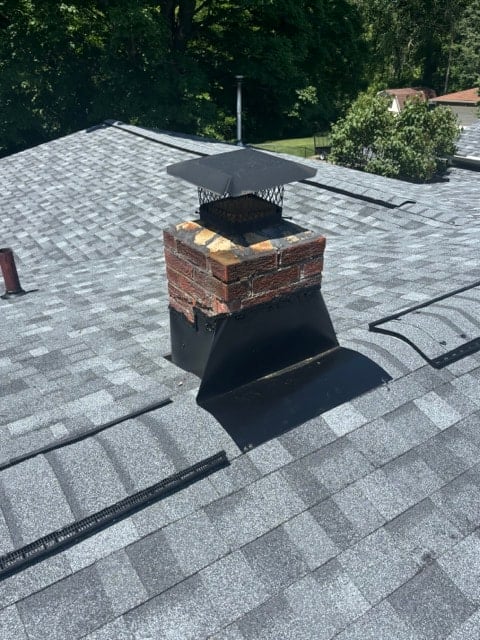- 0 Comment
The Unsung Hero of Your Roof: The Humble Chimney Cricket
While most homeowners spend their time admiring the architectural beauty of their roof, there’s a silent guardian working tirelessly behind the scenes: the chimney cricket. This unsung hero might not chirp or sing, but it plays a vital role in protecting your home from the elements.
What is a Chimney Cricket?
Despite its name, a chimney cricket has nothing to do with the chirping insects. Instead, it’s a triangular-shaped wedge of wood installed behind a chimney on a sloping roof. This wedge diverts water away from the chimney and channels it smoothly down the roof planes into the gutters.
Why is a Chimney Cricket Important?
Chimneys are notorious for creating water pooling problems. Here’s why a cricket is crucial:
- Water Enemy Number One: Imagine rain cascading down your roof. When it reaches the chimney, the water flow gets disrupted. This can cause pooling behind the chimney, where it can seep under flashing and into the underlying structure. Over time, this moisture can lead to leaks, rot, and even structural damage.
- Flashing Frenzy: Flashing, the specialized material that seals the junction between the roof and chimney, is only effective if water flows freely away from it. A cricket ensures proper water drainage, preventing the flashing from deteriorating prematurely.
- Chimney Health: Water damage weakens the mortar joints in your chimney, allowing cracks to develop. These cracks become entry points for water, further accelerating the deterioration process. A cricket keeps water away from these vulnerable areas, promoting a healthy and long-lasting chimney.
The Cricket Advantage
Here are some additional benefits a cricket offers:
- Ice Dam Prevention: In colder climates, ice dams can form at the meeting point of the roof and chimney. A cricket helps prevent this by ensuring proper water flow and melting.
- Peace of Mind: Knowing your roof and chimney are well-protected offers peace of mind, especially during heavy rain or snowfall.
Do I Need a Chimney Cricket?
Building codes don’t always mandate a cricket, but most professional roofers highly recommend them, especially for:
- Large Chimneys: Wider chimneys create a bigger water dam, making a cricket even more critical.
- Steep Roofs: Steeper slopes accelerate water flow, increasing the risk of pooling behind the chimney.
- Multiple Flues: Chimneys with multiple flues create more complex water flow patterns, making a cricket a wise investment.
Cricket Installation: A Team Effort
Installing a cricket is best left to a qualified roofer. Here’s a simplified breakdown of the process:
- Planning and Measurement: The roofer will assess your roof pitch and chimney size to design the perfect cricket.
- Wood Construction: The cricket is typically built with treated wood, cut to precise angles.
- Flashing Integration: The cricket is integrated seamlessly with the existing flashing system, ensuring a watertight seal.
- Shingle or Metal Covering: The cricket is then covered with shingles or metal roofing material to match your roof.
Keeping Your Cricket Chirping (Metaphorically)
While a cricket requires minimal maintenance, an annual inspection during your chimney sweep is recommended. The inspector will check for any signs of wear and tear or debris buildup that could hinder water flow.
Conclusion: A Small Investment, Big Benefits
The chimney cricket might not be the most glamorous part of your roof, but it plays a vital role in protecting your home from water damage. By ensuring proper water flow away from your chimney, a cricket saves you money on repairs and headaches down the road. So, the next time you look at your roof, give a silent thanks to the hardworking cricket, the unsung hero keeping your home dry and safe.

